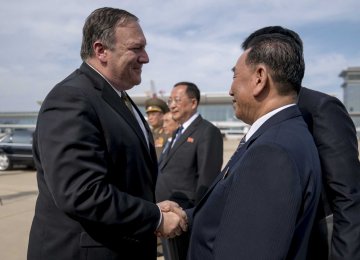US Secretary of State Mike Pompeo wrapped up two days of talks with senior North Korean officials on Saturday without meeting Kim Jong-un but with commitments for new discussions on denuclearization and the repatriation of the remains of American soldiers killed during the Korean War.
Before departing Pyongyang, Pompeo told reporters that his conversations with senior North Korean official Kim Yong-chol had been “productive”, conducted “in good faith” and that “a great deal of progress” had been made in some areas. But he stressed that “there’s still more work to be done” in other areas, much of which would be done by working groups that the two sides have set up to deal with specific issues, AP reported.
Pompeo said a Pentagon team would be meeting with North Korean officials on or about July 12 at the border between North and South Korea to discuss the repatriation of remains and that working-level talks would be held soon on the destruction of North Korea’s missile engine testing facility.
In the days following his historic June 12 summit with Kim Jong-un in Singapore, US President Donald Trump had announced that the return of the remains and the destruction of the missile facility had been completed or were in progress.
Pompeo, however, said more talks were needed on both. “We now have a meeting set up for July 12—it could move by one day or two—where there will be discussions between the folks responsible for the repatriation of remains. [It] will take place at the border and that process will begin to develop over the days that follow,” he said as he boarded his plane for Tokyo.
Missile Engine Plant
On the destruction of the missile engine plant, Pompeo said, “We talked about what the modalities would look like for the destruction of that facility as well, and some progress there as well, and then we have laid out a path for further negotiation at the working level so the two teams can get together and continue these discussions.”
Earlier, Pompeo and Kim Yong-chol both said they needed clarity on the parameters of an agreement to denuclearize the Korean Peninsula that Trump and Kim Jong-un agreed to in Singapore.
The trip was Pompeo’s third to Pyongyang since April and his first since the summit. Unlike his previous visits, which have been one-day affairs during which he has met with Kim Jong-un, Pompeo spent the night at a government guesthouse in Pyongyang and did not see the North Korean leader, although US officials had suggested such a meeting was expected. State Department spokeswoman Heather Nauert said no meeting with Kim Jong-un had been planned.
As they began their talks on Saturday, Kim Yong-chol alluded to the fact that Pompeo and his delegation had stayed overnight in Pyongyang.
“We did have very serious discussions on very important matters yesterday,” Kim said. “So, thinking about those discussions you might have not slept well last night.”
Pompeo, who spoke with Trump, national security adviser John Bolton and White House chief of staff John Kelly by secure phone before starting Saturday’s session, replied that he “slept just fine.” He added that the Trump administration was committed to reaching a deal under which North Korea would denuclearize and realize economic benefits in return.
Kim later said that “there are things that I have to clarify” to which Pompeo responded that “there are things that I have to clarify as well.”
Growing Skepticism
There was no immediate explanation of what needed to be clarified, but the two sides have been struggling to specify what exactly “denuclearization” would entail and how it could be verified to the satisfaction of the United States.
Pompeo and Kim met for nearly three hours Friday and then had dinner amid growing skepticism over how serious Kim Jong-un is about giving up his nuclear arsenal and translating the upbeat rhetoric following his summit with Trump into concrete action.
On his flight to Pyongyang, Pompeo said both sides made commitments at the Singapore summit on the complete denuclearization of North Korea and on what a transformed relationship between their two countries might look like.






Add new comment
Read our comment policy before posting your viewpoints